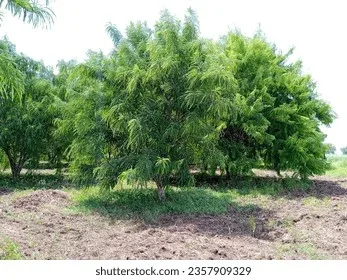Imbued with centuries of traditional wisdom from the heartlands of India, Ayurveda embraces nature’s bountiful offerings to support holistic health and well-being. At the core of this ancient system lies a reverence for plants and botanical derivatives, and one tree, in particular, holds a special place in the tapestry of Ayurvedic healing. Join us on a journey through the foliage to discover the potent contributions of this Ayurvedic marvel and how it can enrich your wellness routine.
Introduction: Embracing Ayurveda for Well-Being
Ayurveda, often termed as the “science of life”, is a holistic approach to health that originated in the Indian subcontinent thousands of years ago. It goes beyond mere healing to promote a way of life that brings body, mind, and spirit into balance with nature. Central to this system is the use of medicinal plants, each with its own unique properties and benefits.
In this comprehensive exploration, we focus on one of Ayurveda’s botanical treasures — a tree that has been woven into the very fabric of Indian culture and health practices for time immemorial. Let’s delve into the significance of this Ayurvedic tree and glean insights into how it can enhance your journey to holistic wellness.
Background of the Ayurvedic Tree
When we speak of the Ayurvedic tree, we refer to a specific botanical species that stands tall as a beacon of health in traditional Indian medicine. This illustrious plant is celebrated for its multi-faceted contributions to Ayurvedic treatments, religious ceremonies, and cultural practices. As we unearth the layers of its story, we discover a tree that is far more than just a source of herbal remedies — it is a living testament to the union of nature and human wellness.
Neem (Azadirachta indica):
Neem, often called the “village pharmacy,” stands tall as one of Ayurveda’s most revered trees.
Medicinal properties of Neem: antibacterial, antifungal, antiviral, anti-inflammatory.
Uses in Ayurvedic medicine: skin conditions, digestive disorders, diabetes, infections.
Neem in cultural and spiritual practices: purification, protection, and reverence.
Sustainable practices and modern applications of Neem in Ayurveda and beyond.
Tulsi (Ocimum tenuiflorum):
Tulsi,
also known as Holy Basil, holds a sacred place in Indian culture and Ayurvedic medicine.
Medicinal properties of Tulsi: adaptogenic, immunomodulatory, anti-inflammatory, antioxidant.
Traditional uses: respiratory ailments, stress relief, digestive disorders, skin care.
Rituals and ceremonies involving Tulsi: worship, purification, spiritual healing.
Contemporary research and global popularity of Tulsi in natural medicine and wellness.
Ashwagandha (Withania somnifera):
Ashwagandha
known as Indian Ginseng, is prized for its rejuvenating and adaptogenic properties.
Medicinal properties of Ashwagandha: adaptogenic, anti-stress, anti-inflammatory, immune-enhancing.
Uses in Ayurvedic medicine: stress management, vitality and vigor, cognitive health, hormonal balance.
Ashwagandha’s role in Ayurvedic Rasayana therapies for longevity and vitality.
Scientific research and clinical studies validating the therapeutic benefits of Ashwagandha.
Amla (Emblica officinalis):
Amla
Indian Gooseberry, is renowned for its high vitamin C content and potent antioxidant properties.
Medicinal properties of Amla: antioxidant, anti-inflammatory, immunomodulatory, hepatoprotective.
Traditional uses: digestive health, immune support, hair and skin care, rejuvenation.
Amla in Ayurvedic formulations: Chyawanprash, Triphala, and various herbal remedies.
Modern applications of Amla in nutrition, beauty, and pharmaceutical industries.
Haritaki (Terminalia chebula):
Haritaki
also known as Chebulic Myrobalan, is esteemed for its cleansing and rejuvenating properties.
Medicinal properties of Haritaki: laxative, detoxifying, anti-inflammatory, anti-aging.
Uses in Ayurvedic medicine: digestive health, detoxification, respiratory conditions, cognitive function.
Haritaki in Ayurvedic formulations and classical texts: Triphala, Avaleha, and Rasayana preparations.
Exploring Haritaki’s role in promoting gut health and longevity in modern contexts.
The Emblem of Traditional Medicine
Botanically classified under a distinct genus, this tree’s leaves, bark, roots, and fruits are harnessed for a myriad of therapeutic uses. Its Sanskrit name is an ode to its healing powers, often translated to imply longevity, vitality, and resurrection. The Ayurvedic tree embodies the ethos of Ayurveda, offering reservoirs of natural medicine to those who seek restoration and balance.
Traditional Uses in Ayurveda
The roots of Ayurvedic lore run deep, and the legacy of this tree within its corridors is universally revered. Disciplined Ayurvedic practitioners and traditional healers have crafted an extensive pharmacopeia around the virtues of this tree, considering it a panacea for many ills.
Healing Properties and Medicinal Uses
The earliest Ayurvedic texts extol the virtues of this tree, documenting its efficacy in treating a variety of ailments. This botanical gem is said to possess astringent, bitter, and sweet tastes — each corresponding to specific physiological benefits when ingested or applied externally. From purifying the blood to aiding digestion, from promoting longevity to calming the mind, its uses are as diverse as they are profound.
Ayurvedic Remedies Derived from the Tree
The various parts of this Ayurvedic tree yield a treasure trove of remedies. The bark is often made into decoctions to alleviate fevers and respiratory conditions, while the leaves are ground into pastes for skin diseases and wound healing. The fruits and seeds are no less valuable, offering tonics for the liver, improving appetite, and acting as cardiac and cerebral tonics.
Health Benefits
As the sun casts its benevolent rays through the leaves of this Ayurvedic tree, the health benefits it offers are illuminated with a radiant, natural glow. The traditional knowledge of Ayurveda sets a precedent for a plant that can bestow a multitude of advantages upon those who seek them.
Physical Health Benefits
The tree’s contributions to physical well-being are substantial. It is reputed to be a powerful anti-inflammatory, a potent anti-pyretic (fever-reducing), and an effective antimicrobial. Those struggling with skin disorders, digestive issues, or endocrine imbalances may find solace in its therapeutic embrace. It is a testament to longevity, with its regular use attributed to enhancing the vitality of body tissues and slowing the aging process.
Mental and Emotional Well-Being
In the domain of mental and emotional health, the Ayurvedic tree offers respite through its calming properties. A tonic for the nervous system, it is believed to pacify Vata dosha — the biological energy that governs movement and the nervous system in Ayurveda. Its presence in herbal preparations aims to bring tranquility to a restless mind and to foster clarity and calm.
Immune System Support
The Ayurvedic tree’s role in bolstering the immune system is also esteemed. Ayurveda attributes immune support to the strength of “Ojas”, a subtle substance associated with vitality and immunity. Regular use of this tree in prescribed forms is believed to enhance Ojas, thus increasing resistance to diseases.
Cultural and Spiritual Significance
Tall and verdant, the Ayurvedic tree stands as a guardian in sacred groves, temple courtyards, and the everyday lives of millions of people. Its influence transcends the realm of physical health, with profound implications for the cultural and spiritual beliefs of its practitioners.
Role in Ayurvedic Rituals and Traditions
The tree plays a central role in many Ayurvedic rituals and traditions, often symbolizing prosperity, growth, and the cycle of life. During religious festivals and rites, its leaves and fruits are offered as sacred offerings, resonating with divine significance and the sanctity of nature’s gifts.
Symbolism and Spiritual Beliefs Associated with the Tree
Culturally, the tree carries great weight, symbolizing purity, fertility, and the interconnectedness of all living beings. Its extensive root system is a metaphor for the deep ancestral ties and the foundations of familial lineage. In the symbolic language of Ayurveda, the tree’s life cycle mirrors the journey of rejuvenation and spiritual growth.
Modern Applications and Research
For a plant entrenched in the ancient Ayurvedic tapestry, relevance in the modern world is not just a possibility — it’s a reality. Scientific research and modern applications are beginning to shed light on the tree’s therapeutic claims and the ways they can be substantiated and integrated into contemporary wellness practices.
Scientific Studies on the Tree’s Therapeutic Properties
Emerging studies within the fields of herbal medicine and ethnobotany have turned their gaze to this Ayurvedic tree, seeking to validate its traditional uses through the lens of modern science. Preliminary findings suggest promising avenues, showcasing bioactive compounds within the tree that support the claims of its healing powers. Research on these compounds hints at a range of therapeutic applications, from antioxidant and anti-cancer potential to maintaining metabolic health.
Integration of the Tree in Modern Ayurvedic Practices
Ayurvedic practitioners, grounded in traditional wisdom yet forward-thinking, are blending the insights from modern research into their treatment modalities. The tree’s extracts, essential oils, and formulations have found their way into modern health supplements, cosmetic products, and functional foods, heralding a new era of personalized wellness supported by time-honored Ayurvedic principles.
Safety and Precautions
While the Ayurvedic tree stands tall as a bastion of health, it is important to approach its usage with the same reverence and respect that Ayurveda teaches. Every botanical, no matter how revered, must be employed with an understanding of both its potential and its precautions.
Potential Side Effects or Interactions
Individuals embarking on an Ayurvedic regimen that includes the tree should remain vigilant for any adverse reactions. Some may experience allergic responses to its compounds, or interactions with existing medication. As with any new addition to one’s health routine, it is wise to consult a qualified Ayurvedic practitioner and a healthcare provider to ensure safety and compatibility.
Proper Usage Guidelines
For the unparalleled benefits of the Ayurvedic tree to be experienced without hindrance, proper usage guidelines must be observed. Doses, durations, and methods of preparation prescribed in Ayurvedic texts should serve as the compass, guiding the journey to wellness. Overconsumption or incorrect preparation can lead to imbalances, negating the very benefits one seeks to obtain.
Conclusion
The fabled Ayurvedic tree from India offers a trove of blessings to those who seek to infuse their lives with the wisdom of Ayurveda. As we sail through the currents of modernity, it beckons us back to the shores of tradition, reminding us that the path to well-being is rooted in the earth and reaches for the skies. Its leaves whisper secrets of the ancients, while its boughs promise shelter and sustenance.
For the admirers of Ayurveda, herbal healers, and wellness enthusiasts, this tree stands not just as a botanical monument but as an evergreen companion on the path to holistic health. In the embrace of its boughs, we find the promise of balance, vitality, and a deeper connection to the natural world. As we nurture this connection, the Ayurvedic tree’s legacy will continue to thrive, ever-creating its rich tapestry in the saga of human well-being.




